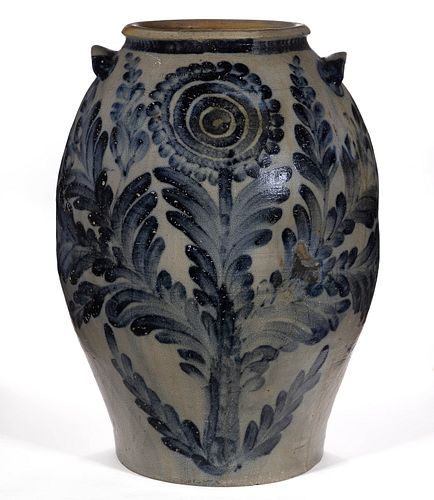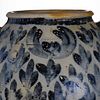- Stoneware/Redware
IMPORTANT DAVID JARBOUR ATTRIBUTED, STAMPED "H. SMITH & CO.", ALEXANDRIA, VIRGINIA DECORATED STONEWARE LARGE JAR
Bid Increments
| Price | Bid Increment |
|---|---|
| $0 | $10 |
| $200 | $25 |
| $500 | $50 |
| $1,000 | $100 |
| $3,000 | $250 |
| $5,000 | $500 |
| $10,000 | $1,000 |
| $30,000 | $2,500 |
| $50,000 | $5,000 |
| $100,000 | $10,000 |
IMPORTANT DAVID JARBOUR ATTRIBUTED, STAMPED "H. SMITH & CO.", ALEXANDRIA, VIRGINIA DECORATED STONEWARE LARGE JAR, salt-glazed, approximately ten-gallon capacity, elongated ovoid form with rounded rim, incised shoulder ring, and applied arched tab handles. Magnificent brushed cobalt decorations including one side featuring an elaborate sunflower with bull's eye center having a bold central stem with several leafy-branch offshoots, many extending partially around side, and reverse having an open bud tulip-like flower encompassing the stamp with approximately 80 three-leaf sprig "turkey foot" ornaments in diagonal rows from top to bottom, additional cobalt band below neck and applied to handle terminals, each side stamped on shoulder. Made for Hugh Smith (1769-1856), Wilkes Street pottery, Alexandria, VA. 1825-1830. 20 3/4" H, 9" D rim, 10 1/4" D base.
Published: Journal of Early Southern Decorative Arts, 2021-2022, vols. 42-43, "...my friend David Jarboe...": The Unfinished Portrait of an Alexandria Potter, by Angelika R. Kuettner, fig. 17. Hunter (ed.) - Ceramics in America 2012, "'Stoneware of excellent quality, Alexandria manufacture' Part I: The Pottery of John Swann," by Barbara H. Magid, p. 134, fig. 35. Wilder - Alexandria, Virginia Pottery: 1792-1876, front cover and p. 123, figs. HS039, a, b, c, and d.
Literature: For a detailed introduction to Jarbour see the Journal of Early Southern Decorative Arts, 2021-2022, vols. 42-43, "'...my friend David Jarboe...': The Unfinished Portrait of an Alexandria Potter" by Angelika R. Kuettner. Hunter (ed.) - Ceramics in America 2012, "'Stoneware of excellent quality, Alexandria manufacture' Part I: The Pottery of John Swann" by Barbara H. Magid, pp. 133-134, 138-139. Wilder - Alexandria, Virginia Pottery: 1792-1876, pp. 36-37; stamp p. 319, fig. Mk V. Myers - The Potters' Art: Salt-Glazed Stoneware of Nineteenth-Century Alexandria, p. 23.
Catalogue Note: The present jar is one of the most highly developed examples of stoneware by an identified African American potter recorded thus far. Its superb construction and grand decoration fully demonstrate David Jarbour's ability as a master potter working on the same level as David Drake. Combined with its stellar provenance and publication history, the appearance of the present jar on the market offers a rare opportunity to acquire a significant example of American folk art by a noted African American artisan.
David Jarbour was born enslaved in the late 1780s or early 1790s. The first public reference of him (listed as David Jarboe) appears in the 1816 Alexandria census, where he was recorded on the same line as Zenas Kinsey; a member of a well-known Quaker family that assisted many in Alexandria's African-American community, both enslaved and free. Jarbour purchased his freedom from Kinsey in December 1820 for $300. It is unknown exactly how Jarbour learned the pottery trade, but a possible source was Lewis Plum (active 1797-1821), a potter who witnessed and signed Jarbour's manumission record. In 1820, there were two extant potteries in Alexandria, one owned by Plum, the other located on Wilkes Street and owned by John Swann, a former student of Plum. In 1824, court records show Jarbour as a complainant in the Insolvent Debtors suit against Swann, whose pottery business was severely suffering at that time. It is suspected that Jarbour appears on the list as an unpaid employee of Swann, perhaps the first evidence Jarbour was working in the pottery industry. Hugh Smith purchased the failing Wilkes Street Pottery from Swann in 1825. Wilder reveals in his book Alexandria, Virginia Pottery, 1792-1876, that the 1826 and 1827 city tax records list David Jarbour's name below Smith, where he was first recorded as a "black potter working for Hugh Smith & Co." In her publication The Potters' Art: Salt-Glazed Stoneware of Nineteenth-Century Alexandria, Suzita Cecil Myers, states that "two free black potters, David Tarbor [sic] and Michael Morris" are employed at the Wilkes Street Pottery until 1834 and that by 1841, Tarbor [sic] had returned. This research helps place Jarbour in time and place, but it wasn't until 1977, when MESDA acquired a signed D. Jarbour jar that his talent as a potter was revealed. The decorative elements featured on the current piece and those found on the signed jar in the MESDA collection were assuredly decorated by the same hand. Angelika Kuettner, in her article "...my friend David Jarboe...": The Unfinished Portrait of an Alexandria Potter, draws comparisons between the only known signed Jarbour piece housed in the MESDA collection and other attributed Wilkes Street pottery decorated vessels having a similar inscribed "D" to the base. According to Kuettner, these examples provide evidence that Jarbour was both a potter and decorator. Hopefully, future discoveries of additional initialed or signed stoneware vessels will help to further the understanding of David Jarbour and his influence on Alexandria pottery.
The current piece is double stamped "H. SMITH & Co." Hugh Smith was a successful china merchant who immigrated to Alexandria in 1795. As previously mentioned, in 1825, Hugh made a notable career change and purchased the failing Wilkes Street pottery from John Swann, who had established the business ten years earlier. Often partnering with relatives, Hugh Smith more than tripled the property assessment for the business on Wilkes Street within one year. Smith, never an artisan himself, hired a number of potters throughout his ownership, many of which were African Americans. David Jarbour, Thomas Valentine, and Michael Morris are presently the only three identified African-American potters working at Wilkes Street. The exuberant cobalt decorations applied to wares during Smith's tenure at the pottery are the most decorative stoneware ever produced at the site, and perhaps the entire South. By 1841, Smith sold the Wilkes Street pottery to potter Benedict C. Milburn.
This exquisite jar was passed down through five generations of the Dulany-Morrison family residing at Old Welbourne, Bluemont, Loudoun County, VA and Welbourne, a large estate and plantation located in Middleburg, Loudoun County, VA. First acquired by John Peyton Dulany (1787-1878) circa 1830, the piece was then bestowed to his son, Richard Henry Dulany (1820-1906). Richard Henry founded the Piedmont Fox Hounds (1840), one of America's oldest fox-hunting organizations, and the Upperville Colt & Horse Show, the oldest horse show in the U.S. Each remains active today. During the Civil War, Dulany served as a C.S.A. officer, first as a captain in the 6th Virginia Cavalry and then as a colonel in the 7th Virginia Cavalry. He lost the use of his left arm after being badly wounded at the Battle of Kernstown. The jar continued to be handed down through his descendants until 1977 when John Palmer, president of Middleburg Bank and a noted stoneware collector/dealer, discovered the piece at the Welbourne estate.
Condition
Excellent, mostly undamaged condition, except having a tight Y-shaped hairline extending partially up one side from base. Manufacturing flaws including some scattered exfoliation/glaze bubbles to cobalt decorations and a few kiln kisses, as made.
Provenance
Collection of the late Al and Billy Steidel, Alexandria, VA.
Ex-collection of Clyde and Frances McClaskey, Fairfax, VA.
John Palmer Antiques, Purcellville, VA.
Descended in the Dulany-Morrison family, Loudoun Co., VA (see catalogue note).
When you are a successful bidder with us you may choose to utilize our in house pack and ship team, pick up your items yourself, or use a third party mover. Shipping within the USA is done through UPS unless otherwise requested and internationally through USPS. We ship to the address on your invoice. We are required by law to collect Virginia State Sales Tax and Nexus Tax where applicable. If you are exempt please read below. List of Third-Party Shippers VIEW LIST Sales Tax on Shipped Purchases Any item purchased by an off-site bidder (e.g. absentee bid, Internet bid, telephone bid,) that is shipped out of the state of VA is subject to sales tax of their state as determined by the Nexus Sales Tax Law. Any item purchased in person at our gallery and then shipped, either in-state or out-of-state, is subject to VA sales tax (because the item was purchased in the state of VA). EXCEPTION: Dealer purchase with all required tax exemption documentation on file. Additional Sales Tax Information may be found on the Virginia Department of Taxation website. Shipping/Packing The buyer is responsible for all associated shipping costs. Credit card on file required for all shipping. Credit card automatically charged once items are packed and ready to ship. Receipt sent to email on file. Standard shipping charges include our packing fee, any applicable materials fee and the cost of delivery with insurance based on the carriers’ current rates. Preferred carriers are UPS (United Parcel Service) within the USA and USPS (United States Postal Service) outside the USA. Our packing service is billed at a prorated fee of $18.00 per hour, with a $10.00 minimum. We use recycled materials whenever possible at no charge to the buyer. If we use purchased supplies such as boxes, etc., that cost is passed on to the buyer. Our UPS account provides for a daily pick up at our gallery, therefore, no handling fee applies to packages shipped via UPS. We offer a professional in-house packing and shipping service and regularly pack and ship glass, ceramics, and antiques and collectibles of all types; however, we do not crate or pack/ship large and/or heavy objects (e.g. furniture, statuary) or items that are unusually fragile (i.e. severely cracked vase). If you are unsure if we can ship a lot for you, please ask before you bid. It is our policy to double-box all glass, ceramics and fragile items with 2-3 inches of padding/cushioning between the inner and outer boxes. We ship for an average of 450 customers after each auction with great success (including international shipments) and we will not compromise on this packing method. You are welcome to make other shipping arrangements if desired. A list of alternate shippers can be provided upon request. We will combine multiple items/lots for shipping whenever possible. If you won by bidding with us directly and also through our online platforms, we can easily combine lots to save on shipping costs. We will gladly provide estimated shipping costs up to one hour prior to the start of the auction. Please call 540.434.3939, ext. 0 or email us with the lot number(s) in which you are interested as well as the delivery zip/postal code and country. It is our sincere intent to provide an accurate shipping estimate (within 20% of actual cost), but we are under no obligation to honor an estimated shipping cost. Post-auction requests for shipping estimates/quotes may delay the actual packing of your items by 1-2 business days. We pack/ship in order of request. We often receive 75-80 requests per day in the first few days following an auction and process approximately 60 shipments per week. Your patience is appreciated. Since items must be packed in order to determine shipping charges, you may elect to send payment by check and provide a credit card for the shipping charges. Shipping charges paid by credit card are not subject to an additional fee. If we have packed for shipping per your request, but the item is ultimately picked up at our gallery, the packing fee will still apply. The buyer is responsible for coordinating pick up or shipment of any merchandise that we do not ship. Such items must be paid in full before leaving our gallery. Buyers are not obligated to use our packing/shipping service and are welcome to make other arrangements. We recommend our local UPS Store, Plycon Transportation Group or you may wish to contact a shipper from this list or search the internet for other options. Merchandise that we do NOT ship must be picked up within two (2) weeks of the sale date unless other arrangements have been authorized by JSE&A. Items not picked up within this time are subject to the storage fees listed below. Any items with an outstanding shipping fee will be subject to the storage fees listed below. The grace period begins once the buyer is notified of shipping charges. Pick Up If picking up at our gallery (2177 Green Valley Lane, Mt. Crawford, VA 22841), please let us know in advance! Our standard hours are Mondays through Fridays from 9:00 am to 5:00 pm ET. If you cannot pick up during the week, you may come during one of our Saturday auctions to pick up; however, we MUST know in advance if you plan to pick up during an auction. On auction days, we open at 8:00 am ET and are here until the end of the auction which varies depending on the number of lots ** Storage Fee Information Items won must be picked up within (2) weeks after the date of the auction. Any items not picked up within (2) weeks of the sale are subject to an additional storage fee. After 35 days, there will be a storage fee implemented, of $10 per day, per large item e.g. furniture, and $5 per day, per small item. Any items that have not been picked up within (90) days of the sale will be considered abandoned and will be resold. UPS & USPS A physical address is required for delivery by UPS. Our default shipping method within the USA is UPS Ground. An adult signature will be required for the delivery of any UPS package with a value of $1,000 or more and any packages that contain antique firearms. Our UPS account provides for a daily pick up at our facility (Monday through Friday only); therefore, with the exception of Canadian and International shipments, UPS is generally less expensive than USPS. No handling fee applies to packages shipped via UPS. If UPS determines that the deliver to address is invalid and subsequently makes a correction in order to deliver your package, an address correction fee may apply. (Currently $18.) (Corrections may include the addition of an apartment or suite number, correction to the street name, correction to zip code, etc.) Be sure to include any additional address information when registering. Shipment of won lots to an address different from that on file may require verification, which can cause up to a 30-day delay in shipping. If we are NOT shipping to the address on your invoice, we must have the alternate delivery address BEFORE packing is completed. If we must make corrections to the delivery address AFTER packing is completed, an additional service charge may apply. Insurance is mandatory unless the buyer provides a written waiver of insurance coverage. The waiver may be sent via email to us provided the email used is the one associated with the winning bidder account. If you have specific packing/shipping instructions (e.g. no insurance, do not double-box), your instructions must be submitted in written form and you accept full responsibility. (Email is acceptable provided that the email used is the one associated with the bidder account.) Unless the buyer has his or her own insurance, shipping without insurance coverage is not recommended and is at the buyer’s risk. Most international shipments are sent via USPS PMI (Priority Mail International); however, restrictions/limitations on allowed package size and insurance coverage vary from country to country. The USPS GXG (Global Express Guaranteed) shipping method may allow additional insurance coverage, but this shipping option is typically much more expensive. We will NOT alter our invoices or customs forms to reflect lesser item value. Invaluable and LiveAuctioneers Winners The address shown on your invoice is as entered in your Invaluable or LiveAuctioneers account. To update how your information displays on your invoice, log in to your Invaluable or LiveAuctioneers account, go to your Profile Page and then Edit Account. Please inform us if you make updates to your Invaluable or LiveAuctioneers account details before your transaction has been completed as it will affect the buyer details shown on your invoice.

















